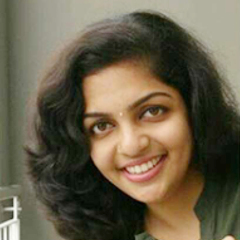Kalamkari unisex wear: cigar-pants, formals and more
Mail This Article
Art is like wine. The more it caters to the tastes of newer generations, the sweeter it gets. One of the oldest textile art-forms in vogue, Kalamkari has traditionally been used to embellish chariots, canvases and wall-clothes. Having spread its wings over Sarees, duppattas and other attires off late, Kalamkari is still regarded as an ethnic textile art. But when the pen-craft paved way for hand printing, block printing and even the computer-based screen-printing techniques, Kalamkari started fitting into modern formal and casual outfits, amusing the fashionistas of Kerala.

The pen-magic on cigarette pants

Kalamkari-printed ankle-length cigarette pants were the main attraction at 'Klum', Kalamkari store in the latest edition of mega flea market in Kozhikode.
Prajina Jaanaki, the designer-entrepreneur behind 'Klum' states that Kalamkari is moving onto modern outfits, dissolving subtly in the sharp cuts of designer jackets, crop-tops, capes and cigarette pants leaving behind sarees and familiar ethnic canvasses.

“Dhoti pants, palazzos, capes and cigarette pants are our experimental modern designs in Kalamkari. Youngsters are going crazy over cigarette and dhoti pants. They match it with their plain cotton or linen tops - both in formal and casual wear,” she says.

'Klum' has a wide collection of scarves, skirts, western dresses and gowns, all embellished with Kalamkari designs.

'Repeat fashion' keeps florals and Buddha in vogue

Round floral designs were the signature Kalamkari pattern when the art created a wave in south India.
Floral Kalamkari prints had secured an endearing place on the borders of traditional Kerala sarees, cotton kurtis and salwar duppattas. Soon came Buddha, a design that rocked the fashion scape.

“People still come in search of Buddha faces,” says Prajina Jaanaki, “Portraits – of human beings, Gods and even birds and animals are still some of the popular patterns.

Perhaps the recent trend of 'repeat fashion,' by which people reuse their costumes with a fashionable tweak, motivates the customers to flaunt outdated trends,” she says.

According to Anjali Chandran, an entrepreneur and founder of 'Impressa' foundation for the preservation and upliftment of traditional textile art-forms, Keralites have a special love of 'fables' when it comes to popular Kalamkari designs.

“Users customize their sarees with different phases of Lord Krishna's and Buddha's life printed upon them. Biblical tales, Ramayana and any course of events represented in different frames find a place on Kalamkari printed attires,” she says.

However, the thickly printed duppattas which narrates Puranic tales go perfectly well with matching plain salwars or kurti-pyjama combinations.

Younsters have also been wearing bright Kalamkari printed pants with plain tops and scarves.
Anjali Chandran says that screen-printing technology encouraged Kalamkari patterns to spread wings over all walks of fashion.
When a single hand-printed Kalamkari saree costed Rs 7000 or 8000 earlier, screen-printing has reduced it to Rs 2500 or 3000. This made Kalamkari an accessible pattern for commoners, she added.
Kalamkari for men
Gone are the days when men restricted themselves to stripes and strokes. Hand-printed Kalamkari kurtas, block-printed duppattas, formal and casual shirts and half kurtas now fill men's.
Fashion-conscious men take Kalamkari attires to parties, weddings and even executive occasions.
Pen-printed unisex harem pants, dhoti-pants and parallels make a distinct look with long-sleeved cotton kurtas.
Kurtas ornated with a single, signature Kalamkari print and formal shirts with Kalamkari collars, pocket frames and hand-cuffs are the new trend among men's fashion in Kerala.
Accessorizing the Kalamkari way
Besides costumes, Kalamkari has also been used widely in customizing accessories like clutches, shoes and bags. A pair of signature-styled Kalamkari shoes with a simple costume gives you a flashy look with no extra makeovers. Saree-bags, party-bags and clutches printed with traditional Kalamkari designs go well with silk and cotton-silk costumes. Apart from containers, the pen-craft is also used to ornate hand-cuffs, earrings and chokers of late.


